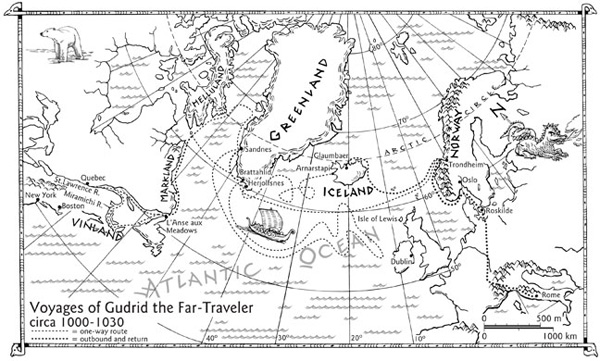
The medieval Icelandic Sagas appear to be a mix of fact and fiction – and no one can agree about which parts are which. Both The Saga of Erik the Red and The Saga of the Greenlanders talk about a woman named Gudrid, who was born in Iceland and who travelled at various times to Greenland, Vinland, Norway, Rome, and eventually to Iceland again where she lived out her days as a nun. While little is known of the details of her life, she seems to have been an adventurous woman who knew her mind and who extremely capable in business and in life – a kickass woman of legend and of history.
In her book, The Far Traveler, Nancy Marie Brown attempts to unravel the fact and fiction behind the life of Gudrid the Far Traveller. She was probably born in 985. The two sagas that mention her vary in details, possibly because they were for different audiences. Says Brown:The Saga of Erik the Red has been traced to a nunnery in northern Iceland, whose abbess was Gudrid’s seven-greats granddaughter: Gudrid was presumably an exemplar, a role model for young Christian women. The Saga of the Greenlanders comes down to us as disjointed chapters in a long saga of the kings of Norway. The discovery of Vinland, rather than Gudrid, lies at its heart.
Both sagas agree on some basic matters: Gudrid was the daughter of a chieftain. When she was a teenager, she went to Greenland with her father. They had a difficult voyage and most of the party died, but Gudrid and her father survived. Gudrid married Thorstein Eiriksson. In doing so, she was marrying into Greenland’s most powerful family, as her new husband was Leif Eiriksson’s brother and Eirik the Red’s son. Depending on the saga, this was either her first or her second marriage.

Gudrid and Thorstein attempted to sail to Vinland, but the voyage failed and they had to come back to Greenland, where Thorstein died of illness. She went back to Iceland and married a merchant named Thorfinn Karlsefni. They travelled to Vinland and stayed for three years at a place that Brown believes was in Newfoundland. While they were there, Gudrid gave birth to a baby boy who is thought to be the first European born on the American continent. She also made contact with the local people, but she was unable to establish peace with them. She and her husband packed their ships with riches from the New World and headed to Norway, and from Norway they returned, very rich, to Iceland.
For the next span of her life, Gudrid lived on a farm in Iceland, where she had a second child and became a widow again. At some point she converted to Christianity and made a pilgrimage to Rome. She sailed to Norway and then to Denmark, and travelled the rest of the way on foot through Central Europe as was customary for pilgrims.
In The Far Traveller, Brown talks about some of the reasons Gudrid might have had for calling herself a nun upon her return from Rome. Gudrid was one of six women in Iceland who had the title “nun” prior to 1186. Brown says:
The Icelandic word translated as “nun”, einsetukona – “Woman living alone”- implies that she enjoyed the independence she undoubtedly had grown used to between Karlsefni’s death and Snorri’s coming of age. She may even have retained control over her wealth, instead of becoming her son’s dependent.
In later years, at least, when a church or chapel was built, all or part of the farm and its income were dedicated to it, with the proviso that the owner could continue to live on and manage the property. On a more personal level, Gudrid as a nun could not be expected to marry and bear more sons, as Gudrun the Fair had at the age of forty. Nor was she brushed aside as a hornkerling, the superfluous old hag sent to live in the corner and be ignored-the fate Hallgerd Long-Legs had feared at age forty-five.
Brown believes that Gudrid initiated the Vinland expedition (she tried to get there twice and only succeeded on the second try). She also believes that Gudrid is the one who decided that it was time to leave Vinland (because she couldn’t reach an accord with the local women). According to The Saga of the Greenlanders:
Making a voyage to Vinland was all anyone talked about that winter. They all kept urging Karlsefni to go, Gudrid as much as the others.
If the sagas are to be believed, Gudrid survived horrible disasters, thrilling adventures, and cultural change. She survived shipwrecks, epidemics, multiple overseas voyages, three years in a new settlement in Vinland, a hike through Europe, and a disapproving mother-in-law who wouldn’t let her live in the house (Gudrid and Karlsefni ended up getting their own farm), and she lived to a respectable old age (she probably died in or around 1050).
My source for this month’s column was The Far Traveller by Nancy Marie Brown ( A | K | G | AB ). This book has some great details about shipbuilding, dairy farming, and weaving. I particularly enjoyed the discussion about clothing – how it was woven, dyed, sewn and what it looked like. There’s also a lot of information about how archeology is done. However, much of the book is speculation.
One thing Brown does well is explain how archeology is a combination of using hard facts that are established with hard science (carbon dating, for example) to create narratives. The narrative is framed around the evidence but is largely speculative. Similarly, the sagas combine things that appear, based on hard evidence, to be factually true with things that appear not to be true (mythological creatures, for instance). Determining ancient history is a matter of trying to match evidence to narrative. Gudrid’s narrative is a kickass story of survival, adventure, and common sense. Whether on a prosperous farm or a sinking ship, Gudrid knew how to make the best of her situation and survive to the next adventure.




Carrie
Thank you so much for this brief bio. I’ve now got the book on my library list.
I love this feature–so many fascinating women!
Thank you! Going on my library list too!
There’s also a recent fictional account of Gudrid’s voyages that I ran across a while back, published as serials in a magazine for young adults. I wish I had more info – title, author – but I think the magazine was Cicada.
I admit this is extremely geeky, but I’m sad the standard transliteration of the eth (“ð”) in English is a “d”. English is one of the few languages (along with Old Norse and modern Icelandic) that has a voiced dental fricative (“th” in “the”), which is what “ð” is. Let’s be more accurate and make use of it!
Oh, and yes, very interesting story 🙂 Even if mostly speculation.
Really fascinating, how are you finding all these kickass women?
Cool! Kid2 is a HUGE fan of Norse mythology and Nordic history. Will point them in the direction of this book. Thanks!
As a woman of Icelandic descent I need to read this book!
My favourite kickass Icelandic woman of history (until now??) was Aud the Deep-Minded. She captained her own ship and began her own settlement in Dalasysla, Iceland, where my ancestors are from. I just loooove the kenning “Deep-Minded”, you know that person has gotta have some serious brainpower! She is in the Laxdaela Saga.
@Charon – I’m wondering if the use of “d” instead of “th” for Eth is intentional because then “th” is used for the Thorn sound? [For those who are curious, “thorn” is the Icelandic letter for the th sound in father. It is kinda like the difference in sound between the word breathe and the word breath.]
Actually, it looks like Thorfinn Karlsefni was one of Aud’s descendants!